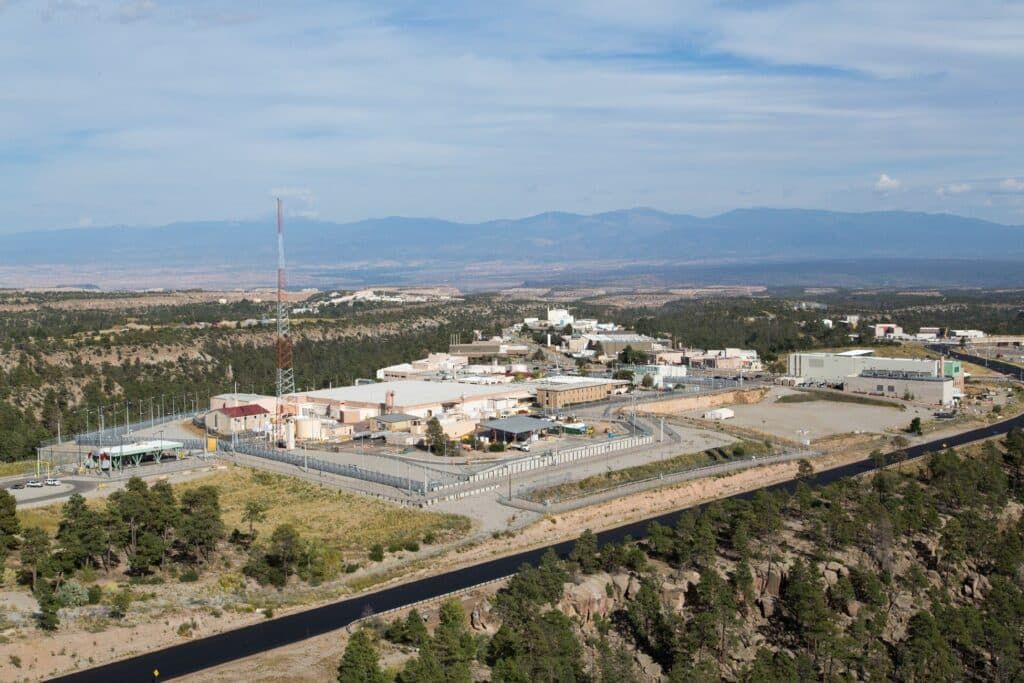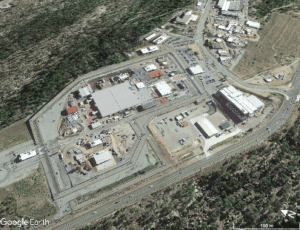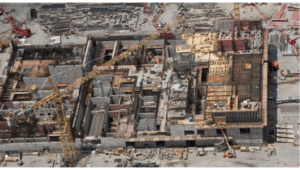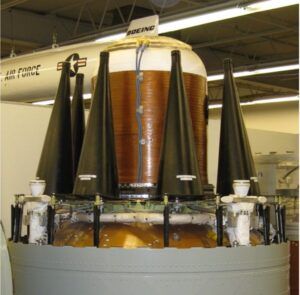Dealing with a debacle: A better plan for US plutonium pit production
By Curtis T. Asplund, Frank von Hippel | April 27, 2023
 The Plutonium Facility at Los Alamos, in front of the Sangre de Cristo mountains. Photo credit: Los Alamos National Laboratory
The Plutonium Facility at Los Alamos, in front of the Sangre de Cristo mountains. Photo credit: Los Alamos National Laboratory
For two decades, the Pentagon and Congress have been increasingly concerned that the United States does not have a reliable capability to produce plutonium “pits,” the cores of US thermonuclear warheads. In 2018, the agency responsible for the production and maintenance of US nuclear warheads, the National Nuclear Security Administration (NNSA), responded with a plan to build, on a crash basis, pit production lines in New Mexico and South Carolina at the same time, with a combined production capacity of 80 pits per year.
One of the production lines is in an advanced state of installation at the Los Alamos National Laboratory in New Mexico, the home of US pit-production expertise. The other is to be installed at the Department of Energy’s Savannah River Site (SRS) in South Carolina, where there is no pit-production expertise, in a massive building that the Department of Energy built for another purpose and was then forced to abandon because of huge cost overruns. South Carolina’s congressional delegation, led by Sen. Lindsey Graham, successfully prevailed on the Trump administration to repurpose this $6 billion building—once known as Mixed Oxide Fuel Fabrication Facility and intended to downblend surplus military plutonium for use as commercial reactor fuel—to plutonium pit production. History is repeating itself, however. The NNSA’s cost estimate for using the Savannah River facility to manufacture warhead pits has already risen from $3.6 billion in 2017 for an 80 pit-per-year production capacity to $11.1 billion for a 50 pit-per-year capacity in 2023.
The NNSA’s rationale for its ambitious pit production program is, to say the least, questionable. The agency proposes to first build 800 pits for new US intercontinental ballistic missile (ICBM) warheads, which would be needed only if the US decides to increase the number of warheads on each missile from one to three. Previous US administrations have considered such uploading destabilizing; silo-based ICBMs are targetable and increasing the number of warheads they each carry would make them more attractive targets. Loading the ICBMs with more warheads would also make compliance with the New START arms control agreement with Russia extremely difficult, should that agreement be extended in 2026.
After producing the ICBM warheads, the NNSA plans to replace all 1,900 US submarine-launched ballistic missile warheads with new warheads, equipped with what is known as insensitive high explosive, which is shock resistant and therefore less susceptible to accidental explosions that could disperse a warhead’s plutonium. No such accident has ever happened with ballistic missile warheads, and it is unclear how much this program would actually improve safety. The warheads in the Trident II missile used by US submarines are located near the missile’s third stage, which carries propellant that is as detonable as conventional explosive.
There is also another concern about the NNSA’s plans: The designs of new warheads in which new plutonium pits would be used may depart from designs that have been previously tested. This could result in demands to resume explosive testing, which would undermine the moratorium on nuclear testing that has been observed by all nuclear-weapon states (other than North Korea) since 1998.
Given these questionable production plans and the already out-of-control cost and schedule of the Savannah River pit production facility, and because the remaining life expectancy of the pits in current US warheads is at least 60 years and perhaps much longer, we propose that the Savannah River facility be put on hold and that the Los Alamos program be focused on demonstrating reliable production of 10 to 20 pits per year. Such a demonstration production line would establish that the United States has the capacity to produce pits and would reduce the time required to build additional production lines, if they are needed.
The NNSA should also renew research programs at the Livermore and Los Alamos Laboratories to study the aging of the already existing plutonium pits in the US arsenal and also the older pits from retired warheads. Before the NNSA cut back this pit-aging research program, the weapons laboratories estimated that the existing pits had expected functional lives of at least 100 to 150 years—that is until at least 2080. Pit-aging research could have huge potential dividends if it helped avoid the cost of premature pit replacement. Given that the NNSA has not adequately supported or published research on pit aging, it is disingenuous for the agency to invoke undocumented and perhaps unfounded concerns about potential pit degradation to justify billions of dollars in spending on new, large-scale pit production programs.
Background to an unfolding debacle. Pits are the hollow plutonium cores of the fission “primaries” (triggers) of two-stage modern warheads. A warhead explosion would begin with the implosion of the pit to supercriticality, which would enable an exponentially growing fission chain reaction in the plutonium. That fission explosion—“boosted” by neutrons from a fusion reaction in tritium-deuterium gas injected into the middle of the hollow pit just before implosion—would ignite a much more powerful “secondary” nuclear fission-fusion explosion.
During the Cold War, the US produced 1,000 to 2,000 pits per year at the Rocky Flats Plant outside Denver, Colorado. The pits now in US nuclear warheads were almost all fabricated there during the 1980s. The plant was a public hazard, however, because of its releases of highly carcinogenic particles of plutonium oxide as a result of plutonium fires and the plant’s waste disposal practices. In 1989, with the end of the Cold War, Rocky Flats was shut down in a joint effort by the Environmental Protection Agency and Federal Bureau of Investigation.
Three years later, the US also stopped underground explosive tests of nuclear warheads, bringing to an end the development of generations of ever-more-compact, high-yield warheads. Post-Cold War arms control agreements reduced the US stock of operational warheads from more than 22,000 at the end of 1989, when the Berlin Wall fell, to fewer than 4,000 at the end of 2021, almost all designed to be deployed on US long-range “strategic” ballistic missiles and bombers. (See Table 1.)

Three decades later, the pits in US nuclear warheads have reached about 40 years of age. Experts from Los Alamos and Lawrence Livermore National Laboratories annually examine sample pits from each type of warhead, both nondestructively and destructively; they continue to find their internal surfaces pristine and that the aging plutonium metal is not becoming significantly less strong or more brittle. In addition, they have been examining pits from older retired Cold War warheads and, since 2002, have been doing accelerated-aging tests.[1]
Nevertheless, the Pentagon and Congress have become increasingly anxious: What would the United States do without a production capacity if a problem should emerge with the existing pits?
In 2006, Congress instructed the Department of Energy (DOE) to focus on producing pits in Los Alamos National Laboratory’s large Plutonium Facility 4 (Figure 1). PF-4 has other plutonium-related missions, however, including extracting plutonium from old pits and fabricating Pu-238 heat sources for space missions. After allowing room for those other missions and production support functions, NNSA found in 2017 that only 19,500 square feet remained available for pit production. Congress also lost confidence in PF-4 being the sole pit production site after Los Alamos struggled for years to produce even a small number of pits there and then shut down major plutonium operations for more than three years after safety infractions in 2013.

The Savannah River Site became the leading candidate for a second pit production facility after a plutonium-disposal project failed there. In 2001, NNSA had given the Savannah River Site the mission of fabricating excess Cold War plutonium into “mixed-oxide” (or MOX) plutonium-uranium fuel for US power reactors. The completion schedule for the MOX Fuel Fabrication Facility slipped steadily and its cost escalated drastically. Congress finally terminated the the MOX facility after NNSA had spent nearly $6 billion on its construction. Under political pressure from most of South Carolina’s congressional delegation, however, the Trump administration endorsed a plan to convert the MOX facility into a pit production factory.
Now, the Savannah pit production project has developed a dysfunctional dynamic quite similar to that which afflicted the MOX facility:
- Billions are being spent on construction and equipment for pit production even though the design of the facility has not been finalized.
- The NNSA is trying to buy hundreds of gloveboxes for material handling on the pit production lines at a greater rate than US glovebox manufacturers are able to produce them. (Ironically, at the same time DOE is scrapping the huge numbers of costly glove boxes it bought in advance for the MOX facility.)
- The complex MOX building contains six hundred rooms, many of whose reinforced concrete walls will have to be broken through to accommodate the glovebox production line (Figure 2).
- The production of a single pit will require tens of person-years of labor. The NNSA is therefore already hiring thousands of pit-production workers for both Los Alamos and the Savannah River Site and training them in plutonium work at Los Alamos at the same time that pit production lines are being installed and unrelated plutonium work is continuing in other parts of the Los Alamos facility. NNSA complains that it is unable to find sufficient qualified workers in the trades required for both the construction of the facilities and their operation.

Are new warhead designs really needed? Ever since US nuclear testing ended in 1992, NNSA’s nuclear-weapon laboratories have been putting forward proposals to replace some of the existing US warhead types with new designs. The labs have developed great expertise in computer modeling of nuclear weapon processes and now feel confident in their abilities to design improved warheads and certify them without explosive nuclear testing. The NNSA emphasizes that deviations from previously tested designs will be small. But warhead designs without a test pedigree could undermine confidence in the reliability of the US stockpile and inspire calls for renewed US testing—a prospect that would endanger the global moratorium that has been observed since 1998 by all nuclear-armed states other than North Korea.
The first new warhead design the NNSA proposes for production would be deployed on the intercontinental ballistic missiles (ICBMs) deployed in 400 underground “silos” scattered across the northern US Great Plains. The current Minuteman III ICBM—which is itself being replaced by a new ICBM—currently carries two warhead types, the W78 and W87. The labs would like to replace the older W78 with an updated version of the W87, which has modern safety features not included in the earlier warheads.
Specifically, the W78s are more vulnerable than the W87s to plutonium dispersal accidents because the conventional explosive used to implode their pits is sensitive to shock.
To replace the W78, NNSA has chosen a design close to that of the W87. Indeed, the new warhead would be given the label W87-1. The W87 has insensitive high explosive to reduce the probability of a plutonium-dispersing conventional explosion if, for example, a bullet were fired into the warhead. The W87 pit also has fire-resistant cladding with a melting point that is designed to contain the plutonium in case of a jet fuel fire (about 1000 oC)—but not in the much hotter temperatures that would be produced by burning missile propellant.
According to NNSA’s current plan, the first 800 or so pits it would produce would be for W87-1 warheads—about 10 years’ output from both of the NNSA’s proposed pit production facilities operating at design capacity. The United States reportedly already has 540 W87 warheads, however, enough to equip its 400 ICBMs with a single warhead each.
The rationale for producing the additional W87-1 warheads appears to be to preserve an “upload hedge,” i.e. the ability to increase the US ICBM warhead loading to three warheads per missile, in case the New Strategic Arms Reduction Treaty (New START) expires without a successor agreement, or if—as is already being urged—the US decides to deploy more strategic ballistic missile warheads in response to China’s nuclear buildup.
Multiple-warhead ICBMs are, by their nature, destabilizing. If each ICBM were to carry three warheads, one attacking warhead could destroy three US warheads, increasing the incentive to strike first in a crisis
There is also reason to question NNSA’s follow-on plans to replace the warheads of US submarine-launched ballistic missiles (SLBMs) with warheads containing insensitive high explosive. The US Navy’s SLBMs have never had a plutonium dispersal accident. Reducing that risk further would require more of a change, however, than new warheads containing insensitive high explosive. The warheads of the Trident II SLBM are arranged around its third stage (Figure 3), whose propellant has explosive characteristics comparable to those of conventional high explosive.

The Trident II’s would still have enough range to deliver their warheads to their targets if the Navy replaced the third stage propellant with nondetonable propellant. This was recommended by a high-level panel three decades ago, but the Navy has not implemented that recommendation. Unless the Navy changes its mind, there is little justification for any decision to replace the SLBM warheads with warheads containing insensitive high explosive.
The possibility of pit reuse. In 2006, the JASON group of independent science advisors who provide consulting service to the US government concluded, on the basis of research done at the Lawrence Livermore and Los Alamos National Laboratories, that the plutonium in existing pits has a functional life expectancy of at least a century. It then added that “[c]ontinued work is required [that] includes … extending accelerated aging experiments on [plutonium], and determining how aging affects primary performance by way of material strength.
In 2012, the Livermore lab announced that it had found “no unexpected aging issues … in plutonium that has been accelerated to an equivalent of ~150 years of age.”
A decade later, Congress asked the JASON group to update its conclusions. JASON reported back in 2019 that the Los Alamos and Lawrence Livermore labs “have made important progress on some of the recommendations of the 2006 JASON Pit Lifetime report. An important example is accelerated aging of Pu to the point where changes in various properties become clearly measureable. But in general, studies on Pu aging and its impacts on the performance of nuclear-weapon primaries have not been sufficiently prioritized over the past decade. A focused program of experiments, theory, and simulations is required to determine the timescales over which Pu aging may lead to an unacceptable degradation of primary performance [emphasis added].”
The Senate Energy and Water Development Appropriations Subcommittee expressed concern about the NNSA’s “apparent lack of focus on advancing knowledge regarding pit and plutonium aging since the JASONs conducted its first study in 2006… Therefore, the Committee directs NNSA to develop a comprehensive, integrated ten-year research program for pit and plutonium aging that represents a consensus program among the national laboratories and Federal sponsors… The plan shall be submitted to the Committees on Appropriations of both the House and the Senate no later 180 days after enactment of this act.”
The NNSA reportedly submitted the required research plan but it has not been made public—perhaps because it classified. In July 2022, the House Armed Services Committee required “the Administrator of the National Nuclear Security Administration to submit to the House Committee on Armed Services not later than April 1, 2023, a briefing that describes its plan to study plutonium aging … [T]he committee directs the Comptroller General of the United States [the director of the GAO] to assess NNSA’s plan to study plutonium aging [and] to provide a briefing to the House Committee on Armed Services not later than August 1, 2023, on the Comptroller General’s findings.” Hopefully, more information will soon become available about NNSA’s research program on pit aging.
All the publicly available evidence to date indicates that plutonium aging is such a gradual process that it remains imperceptible for more than 150 years. It was only in 2019, when accelerated-aging samples were the equivalent of more than 250 years old, that the second JASON review reported “changes in various properties [had] become clearly measureable.”
The plutonium pits in US nuclear warheads are now only about 40 years old. The United States has about 15,000 excess and reserve pits from dismantled Cold War warheads stored in NNSA’s Pantex warhead assembly/disassembly plant in Amarillo Texas. Some NNSA officials argue that our understanding of pit aging is inadequate and one senior official recently claimed, on a pit production panel at the 2023 Nuclear Deterrence Summit, that reusing old pits might very well be “highly suboptimal” (recording provided by the Los Alamos Study Group). According to the 2019 JASON report, however, the uncertainties about pit aging are due in considerable part to the NNSA’s failure to give pit-aging studies adequate priority since the 2006 JASON report found that US pits would continue to be functional for at least 100 years.
A better way: pit production at a scale of 10 to 20 per year. As of September 30, 2020, the US nuclear stockpile contained 3,750 operational warheads. Of these, approximately 1,800 were deployed and the remainder constituted a reserve that could be used to either replace warheads withdrawn for servicing or to increase deployments.
Based on the pit monitoring and plutonium-aging studies to date, scenarios in which aging problems suddenly develop appear unlikely. If such a situation were to occur, however, an 80-pit-per-year production capacity would have to be expanded fivefold to replace all the pits in the stockpile within a decade. Congress’ current concern therefore is driven in good part by the fact that NNSA has not demonstrated that it can reliably produce pits on any scale. If NNSA could demonstrate reliable production of even 10 to 20 pits annually, that reliable production line could be the basis for constructing additional production lines, if they become necessary.
Trying to build a second pit production facility at the Savannah River Site in a building designed for another purpose while simultaneously re-equipping Los Alamos’s plutonium facility and crowding it with hundreds of trainees for both facilities is a prescription for a fiasco. The NNSA will have a better chance for success if it focuses on getting one well-designed pit production line up and working well.
The obvious place for such a pit production line is at the Los Alamos Plutonium Facility, the center for US pit-production expertise. In fact, the current focus at Los Alamos is to do exactly that. According to a recent GAO review, “The scope of work at Los Alamos … involves a range of activities necessary to achieve the capability to reliably produce 10 pits per year… [including] gloveboxes and equipment for melting, casting, and machining processes.”
“Development pits” are already being produced. These are pits that have not passed all the necessary quality requirements to be used in warheads.
Beyond that, there are separate projects devoted to acquiring equipment to expand the PF-4 production capacity to 30 pits per year and to hiring and training 1,600 new full-time-equivalent employees for the plutonium facility. Some have argued that these expansions would exceed the area’s capacity for worker housing and transport. Limiting pit production to 10-20 pits per year might be beneficial from that perspective.
A crash effort to manufacture new plutonium pits for the US nuclear arsenal might be justified if a crisis existed. Given that the remaining longevity of the existing pits is at least several decades, if not a century or more, a step-by-step approach makes more sense than the wasteful approach currently being pursued. Such a measured approach should also reduce the likelihood of potential threats to worker and public health from plutonium accidents, which are more likely to occur with a deadline-driven, unnecessarily large pit production plan. Congress should pause the construction of the Savannah River pit production facility and ask for an independent review by the Government Accountability Office of alternative approaches, such as that suggested in this paper, before sinking more funds into the apparently bottomless pit of the current pit-production program. No one should want a repeat of the MOX program debacle to play out in the same building.
Acknowledgements: We thank Tom Clements of SRS Watch, Jay Coghlan of Nuclear Watch New Mexico, Marylia Kelley of Tri-Valley CAREs, Dylan Spaulding of the Union of Concerned Scientists, and Sharon Weiner of the Carnegie Corporation and American University for providing valuable information and insights. The conclusions presented in this paper are, however, our own.
Notes
[1] Such tests inflict 16 years of equivalent radiation damage per chronological year on samples of plutonium metal spiked with 7.5 percent of the short-lived isotope, plutonium 238.
Together, we make the world safer.
The Bulletin elevates expert voices above the noise. But as an independent nonprofit organization, our operations depend on the support of readers like you. Help us continue to deliver quality journalism that holds leaders accountable. Your support of our work at any level is important. In return, we promise our coverage will be understandable, influential, vigilant, solution-oriented, and fair-minded. Together we can make a difference.
Keywords: Los Alamos National Laboratory, MOX Fuel Fabrication Facility, NNSA, PF4, Savannah River Site, plutonium pits
Topics: Nuclear Weapons
















Dear Curtis and Frank — there are serious, besetting factual errors in this article, which could mislead policymakers. Hopefully the Bulletin will allow a response. We will in any case provide a detailed response, at lasg.org as well as elsewhere. Best, Greg Mello
Dear Greg, thank you for reading our article and taking the time to comment. We are aware that you disagree with some of our opinions and conclusions in this article, but we point out that you have accused us of serious factual errors without specifically indicating any of them. We look forward to reading a more detailed response whenever it’s available.
Overall, this paper is uninformed, materially false in most relevant respects, and misleading. The basic structure of the argument is simply this: let’s halt all investment in a new, adequate, reliable, and enduring pit production facility at the Savannah River Site (SRS), which would begin production in the late 2030s if and as needed, in favor of continuing all planned investment in pit production at Los Alamos National Laboratory (LANL). Not mentioned is that the LANL facilities are old, more expensive to retool, unsafe, and cannot begin “reliable” production until the early 2030s at a grossly inadequate level given the… Read more »
Dear Curtis — I think I need to add here that I did comment in some detail to you prior to publication in some 15 emails, and prior to your involvement I count another 16 emails, even more detailed, to Frank. What you say in your comment above is just not true. I also briefed Frank together with government officials in detail on multiple occasions and published those briefings on our web site along with subsequent up-to-date references and analysis, as you know. So yes, I did specifically point out the factual errors in your article. While I do disagree… Read more »
The DOE should have known better than to bow to public pressure and shut down and then dismantle Rocky Flats. It’s an example of allowing politicians with no factual information to dictate national defence policy.
The EPA and the FBI raided Rocky Flats for repeated, illegal incineration of radioactive waste. This was NOT about public pressure on politicians,
Why is DOD/DOE “sinking more funds into the apparently bottomless pit of the current pit-production program”?
This article leans heavily on the JASON report but fails to mention this ultra-relevant line from the unclassified summary: the authors “urge that pit manufacturing be reestablished as expeditiously as possible in parallel with the focused program to understand Pu aging, to mitigate against potential risks posed by Pu aging on the stockpile.”